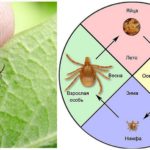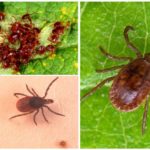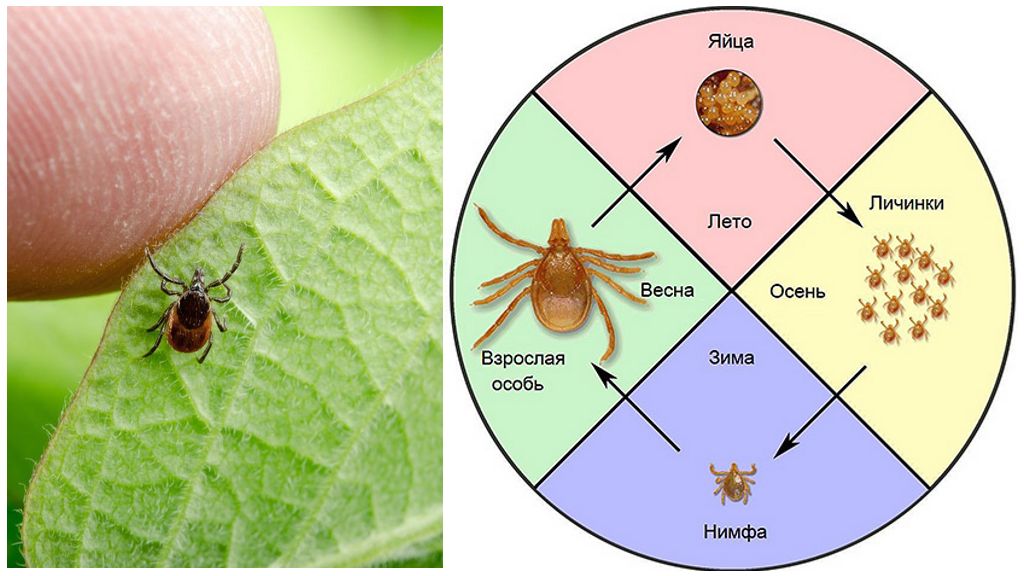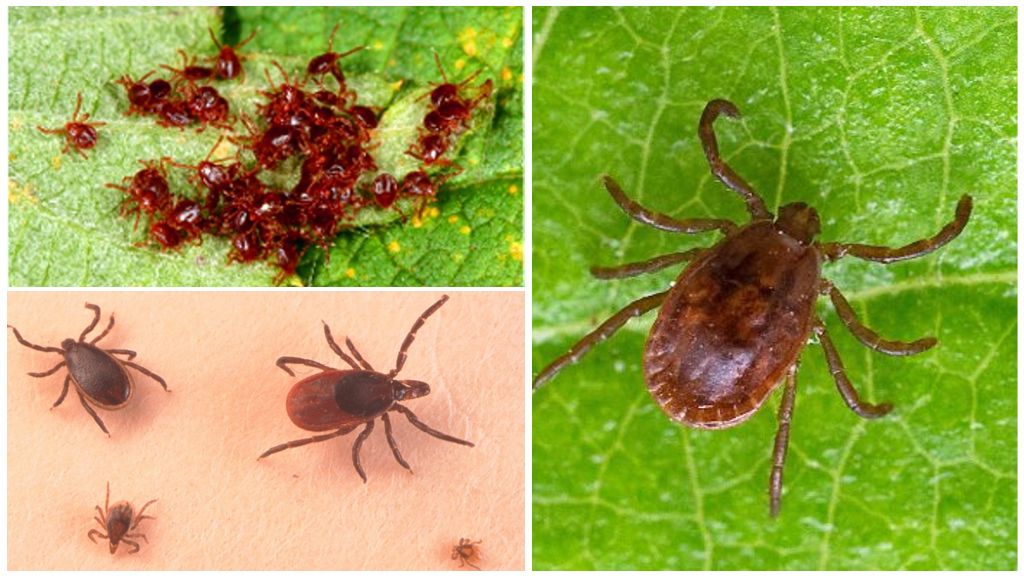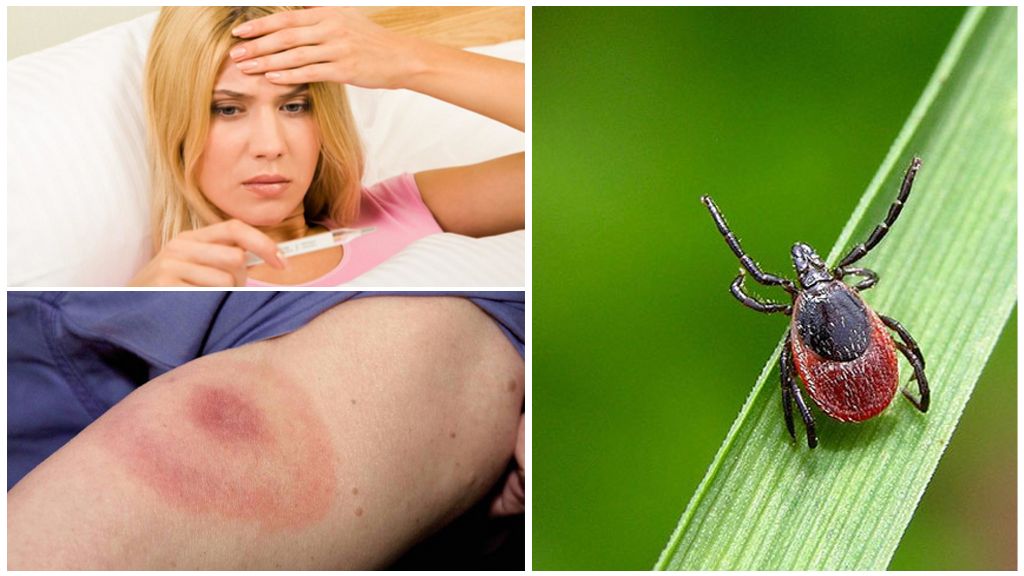Description and photo of ixodic ticks
Content
- Tick life cycle
- Tick larva
- Tick Disease
Ixodes are one of the most common parasites that inhabit our planet. They are able to live in different climatic conditions, very successfully find the "owner" and transmit a rather dangerous infection. Modern science knows more than six hundred species of ticks. Habitat of bloodsuckers covers almost all areas of the Earth, are not exception even the Arctic and Antarctic.On the territory of Russia you can meet representatives of 70 species, the most dangerous and common are dog and taiga ticks, the fight against which is relevant today.
Morphological signs of ixodic ticks
The ixodid tick is a blood-sucking parasite of terrestrial vertebrates (birds, reptiles and mammals), which is a member of the family of ticks of the Ixodida class of the arachnid class. The bloodsucker is a fairly large individual: the female grows to 4 mm, the male - no more than 2.5 mm. A full tick can reach 1 cm. It is possible to determine a saturated parasite by color: in normal condition, its body is dark red or brown in color, after a meal the parasite becomes light gray in color.
The males on the back have a thickened shiny chitinous formation that covers the entire body, but in females it covers only a third part. It is possible to examine more clearly the structure of arthropods in the photo of Ixodes tick presented below.
On a flat oval body are 4 pairs of legs. The oral apparatus of the tick has its own characteristics: its proboscis is equipped with a long flat outgrowth with sharp lateral teeth, thanks to which the parasite reliably attaches to the victim’s tissues, gnaws at it and reaches the blood vessel.
On a note!
When the bloodsucker starts sucking the wound in the skin, it begins to suck the blood of its host until it is completely saturated, and the duration of this process can take several days until the pest is detected.
Life cycle
Each species of mite has a certain developmental cycle, the duration of which varies from the habitat of the individual and the presence of food (the victim). On average, the life span of Ixodes ticks is 1-4 years.
Ixodes ticks usually mate on the body of their victim, in the external environment such a process is extremely rare. Most often, the male approaches the female at the time of her meal, at the end of the process the male individual dies.
Saturated with blood and fertilized female leaves the body of her victim, going in search of a suitable place for laying eggs. Usually it hides under plant debris or in soil cracks, where for 30-60 days (depending on temperature conditions) it makes laying eggs up to 0.5 mm in size.
On a note!
The number of eggs laid at a time depends not only on the species, but also on the portion of the sucked blood.During the life of one female is able to lay up to 15-17 thousand eggs.
Egg development
The period of development of eggs takes about 2-10 weeks, depending on environmental conditions, in case of large differences in humidity and air temperature, the future individual dies. The development of embryos slows down when eggs get into the water; it resumes only after their extraction from this environment.
Development of larvae
After some time, the larva of the Ixodes tick, the dimensions of which do not exceed 1 mm, is born. The development of an individual in this stage can take from 7 to 30 days. A prerequisite for this stage of development is the availability of nutrients, in connection with which, the larva goes in search of its first victim. Most often it serves birds or rodents. The larva, which has been feeding for several days (from 2 to 5 days) with blood, leaves the host's body, appearing on the soil surface. After that, in the presence of favorable conditions, it will reincarnate at the end of the month to the nymph stage, remaining to spend the winter in this state.
On a note!
The larva is able to live in a state of hunger for two years, however, the individual will not undergo further development.
Nymph development
With the advent of heat, the nymph becomes active, going in search of a second owner, which can serve not only a rodent and a pet, but also a man. Outwardly, only the more compact body size distinguishes it from an adult tick. The duration of development at this stage takes no more than 5 weeks. Moreover, a significant part of the time (3-8 days) is the process of feeding: the individual absorbs large amounts of blood, thereby increasing in size and turning into an adult individual (imago). Then the mature individuals reproduce again.
Types of ticks
Two types of ticks are especially dangerous to domestic animals and humans: the dog (Ixodes ricinus) and the taiga (Ixodes persulcatus). They are also distributed on the territory of the Russian Federation. And if the former live in a wide geographic area, then the latter are found throughout the taiga from Primorye to the Urals.
The nymphs and larvae of these parasites feed on small rodents, birds, and reptiles. Adults are primarily parasitic to large and medium-sized mammals, both wild and domestic. Ticks are often attached to a person.Moreover, taiga ticks are especially aggressive.
What is dangerous ixodic tick for a person?
Many types of ticks are carriers of relapsing tick-borne typhus, ehrlichiosis, hemorrhagic fevers, tularemia and other dangerous infectious diseases. According to medical estimates, thousands of people become infected with them every year.
For the territory of our country, infections such as:
- Tick-borne encephalitis is a disease caused by a pathogen that enters the human body along with the parasite's saliva. Even if you quickly pull out a tick that has been infected with such a virus, the person will still get infected. A person with encephalitis affects the central nervous system, and fever symptoms appear. The consequence of which could be disability and even death.
- Borreliosis or Lyme disease - a disease that is accompanied by various symptoms. In addition to the cardiovascular, nervous and musculoskeletal systems, respiratory organs and the urogenital system can be affected. The cause of the disease becomes a special type of spirochete.In the case of this disease, the bacterium that lives in the parasite's digestive tract is released from its body during feeding and enters the victim's bloodstream. This usually occurs 2-3 hours after the bite. Therefore. if we notice and remove the Ixodes tick in time, then infection can be completely prevented.
Important!
However, it is sometimes quite difficult to separate from the host of the sucked tick, in such situations, you should immediately seek medical help, since the consequences of the introduction of the parasite into the human body may be irreversible.
Knowing how many parasites live, how quickly they multiply, and what consequences their bites can have, you need to use not only the right equipment when entering the forest, but also special means of protection. Only timely control measures will help prevent the attack of bloodsuckers and avoid negative consequences.

